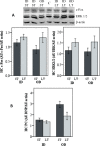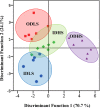Housing and road transport modify the brain neurotransmitter systems of pigs: Do pigs raised in different conditions cope differently with unknown environments?
- PMID: 30650149
- PMCID: PMC6334955
- DOI: 10.1371/journal.pone.0210406
Housing and road transport modify the brain neurotransmitter systems of pigs: Do pigs raised in different conditions cope differently with unknown environments?
Abstract
How housing and transport conditions may affect welfare in porcine production is a leading topic in livestock research. This study investigated whether pigs present a different neurological response to management conditions and to ascertain whether pigs living partially outdoors cope differently with road transport-associated stress. Twenty-four female pigs were divided in two groups: one living indoors (ID, n = 12) and the other housed combining indoor conditions with 4 hours per day of outdoor pasture (OD, n = 12). After one month, one set of animals from each housing condition were driven in a truck to the slaughterhouse in low-stress conditions (5 min drive, no mixing groups, soft management, LS group, n = 12) or high-stress conditions (2 hours drive, mixing groups, harsh management, HS group, n = 12). At the slaughterhouse, blood was collected, and the prefrontal cortex (PFC) and the hippocampus (HC) dissected. OD pigs had lower serum haptoglobin and increased dopaminergic pathway (DA-system) in the PFC, suggesting that living outdoors increases their wellbeing. HS conditions increased serum creatine kinase (CK) and affected several brain pathways: activation of the noradrenergic (NA-system) and DA -system in the PFC and the activation of the DA-system and an increase in c-Fos as well as a decrease in brain-derived neurotrophic factor (BDNF) in the HC. The serotonergic system (5-HT-system) was mildly altered in both areas. There was an interaction between housing and transport in serum NA and the DA-system in the HC, indicating that living conditions affected the response to stress. Multivariate analysis was able to discriminate the four animal groups. In conclusion, this work indicates that housing conditions and road transport markedly modifies the neurophysiology of pigs, and suggests that animals raised partially outdoors respond differently to transport-associated stress than animals raised indoors, indicating that they cope differently with unknown environments.
Conflict of interest statement
AV is currently working in IRTA, a public research institution belonging to the catalan government. AV was member of the Animal Health and Welfarer Panel of the European Food Safety Authority (EFSA) from 2012 until July 2018. This does not alter our adherence to PLOS ONE policies on sharing data and materials.
Figures



Similar articles
-
Brain-derived neurotrophic factor in serum as an animal welfare indicator of environmental enrichment in pigs.Domest Anim Endocrinol. 2018 Oct;65:67-70. doi: 10.1016/j.domaniend.2018.05.007. Epub 2018 Jun 4. Domest Anim Endocrinol. 2018. PMID: 30007130
-
Early human contact and housing for pigs - part 2: resilience to routine husbandry practices.Animal. 2024 Jun;18(6):101165. doi: 10.1016/j.animal.2024.101165. Epub 2024 Apr 18. Animal. 2024. PMID: 38776694
-
Preweaning housing effects on behavior and physiological measures in pigs during the suckling and fattening periods.J Anim Sci. 2007 Jul;85(7):1741-9. doi: 10.2527/jas.2006-504. Epub 2007 Mar 30. J Anim Sci. 2007. PMID: 17400972
-
Review: Early life piglet experiences and impacts on immediate and longer-term adaptability.Animal. 2024 Jun;18 Suppl 1:100889. doi: 10.1016/j.animal.2023.100889. Epub 2023 Jun 22. Animal. 2024. PMID: 37468352 Review.
-
2011 and 2012 Early Careers Achievement Awards: farm and pig factors affecting welfare during the marketing process.J Anim Sci. 2013 Jun;91(6):2481-91. doi: 10.2527/jas.2012-6114. Epub 2013 Mar 11. J Anim Sci. 2013. PMID: 23478817 Review.
Cited by
-
Serum concentrations of brain-derived neurotrophic factor as a potential biomarker of swine welfare.Can Vet J. 2023 May;64(5):474-478. Can Vet J. 2023. PMID: 37138716 Free PMC article.
-
Effects of Positive Human Contact during Gestation on the Behaviour, Physiology and Reproductive Performance of Sows.Animals (Basel). 2021 Jan 16;11(1):214. doi: 10.3390/ani11010214. Animals (Basel). 2021. PMID: 33467148 Free PMC article.
-
Enriched environment housing improved the laying hen's resistance to transport stress via modulating the heat shock protective response and inflammation.Poult Sci. 2021 Mar;100(3):100939. doi: 10.1016/j.psj.2020.12.036. Epub 2020 Dec 19. Poult Sci. 2021. PMID: 33652541 Free PMC article.
-
Animal Welfare Assessment and Meat Quality through Assessment of Stress Biomarkers in Fattening Pigs with and without Visible Damage during Slaughter.Animals (Basel). 2024 Feb 23;14(5):700. doi: 10.3390/ani14050700. Animals (Basel). 2024. PMID: 38473085 Free PMC article.
-
Identifying Physiological Stress Biomarkers for Prediction of Pork Quality Variation.Animals (Basel). 2020 Apr 2;10(4):614. doi: 10.3390/ani10040614. Animals (Basel). 2020. PMID: 32252489 Free PMC article.
References
-
- Marchant JN, Rudd AR, Broom DM. The effects of housing on heart rate of gestating sows during specific behaviours. Appl Anim Behav Sci. Elsevier; 1997;55: 67–78. 10.1016/S0168-1591(97)00022-1 - DOI
-
- Millet S, Moons CP, Van Oeckel MJ, Janssens GP. Welfare, performance and meat quality of fattening pigs in alternative housing and management systems: a review. J Sci Food Agric. 2005;85: 709–719. 10.1002/jsfa.2033 - DOI
-
- Honeyman MS. Extensive bedded indoor and outdoor pig production systems in USA: current trends and effects on animal care and product quality. Livest Prod Sci. 2005;94: 15–24. 10.1016/j.livprodsci.2004.11.029 - DOI
-
- Terlouw C, Berne A, Astruc T. Effect of rearing and slaughter conditions on behaviour, physiology and meat quality of Large White and Duroc-sired pigs. Livest Sci. 2009;122: 199–213. 10.1016/j.livsci.2008.08.016 - DOI
Publication types
MeSH terms
Substances
LinkOut - more resources
Full Text Sources
Research Materials
Miscellaneous

